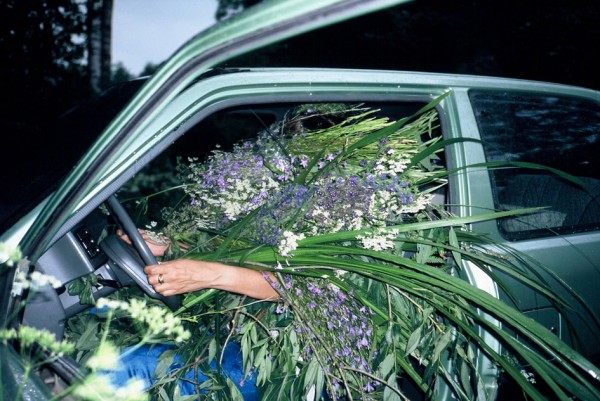Melanie Bonajo
Monday, 24 October 2011
Work from her oeuvre. Text by Wyatt Niehaus.
In her photographs, videos, installations and performances Melanie Bonajo approaches paradoxes of domestic life within a culture of free-time and luxury, the facets of a Modernized Society that remove from the individual the feeling of belonging, and increase feelings of isolation and identity issues related to our shifting relationship to nature. She is interested in belief systems and opposes our mechanical point of view by generating a substitute universe. Established norms of moral, mental and social order incorporated into the everyday life of a society’s population are challenged and put on trial.”- Melanie Bonajo artist statement
Melanie Banajo is a Dutch artist, currently taking part in a yearlong residency at the Kunstlerhaus Bethanian in Berlin. Her work spans photography, performance, video, and installation and her conceptual focus is equally as expansive. Bonajo’s work addresses concepts of mysticism, naturalism, and objecthood and the conflict that arises amongst these issues. When looking over her portfolio and publications, it becomes clear that her oeuvre contains a wide breadth of themes and ideas. In one moment her work plays with activism and social awareness and in another it may seem as though it retreats into fantasy. In her popular “Bondage” series, the viewer finds the female form entrapped and constricted by objects- chairs, cords, brooms, etc. At a glance, Bondage appears to be loaded with radical symbolism that encapsulates notions of feminism and acts as critique of object-fetishism. Yet as these videos progress, one half of a dialogue emerges through phone conversations. The conversations are performed transcriptions of dreams, scavenged from friends and family of the artist. The conversations, as you might expect, are bizarre and aloof- a collage of recollections and confusing descriptions. The addition of these conversations seem to push the works further from a straightforward criticism of commodity and capitalist-entrapments and into a place that is a little less quantifiable.
When speaking with Bonajo, she seems quite reluctant to identify her art as being in any one place on this spectrum. She pushes herself to accept a fantastic interpretation of reality- a kind of forced spiritual awakening. When viewing pieces from Bush Compulsion, you may get the sense that these ideas are not entirely genuine. As a viewer, I am constantly reassessing Bonajo’s viewpoint on the concepts which inform her work. Is she co-opting the imagery of a subculture that she has no real connection with, or does it come from a genuine desire to break from urban life, or perhaps industrialism as a whole? Though there is no shortage of young photographers dealing with these issues on a surface level (see Ryan McGinnley), something about Melanie Bonajo’s work feels more aware- as if she is more interested in the place that these subcultures occupy in our society and less interested in the ideologies surrounding the subculture itself. Some work takes on a kind of fictional-anthropology. She creates detailed backstories and manifestos to inform her photographs, allowing viewers to understand the fictional circumstances that lead to the photographs and performances. Wherever her interests may actually lie, it feels obvious that Bonajo is able to approach her art as both a pragmatist and a dreamer.
Images in Melanie Bonajo’s portfolio run the gamut between eye-catching, absurdist iconography and mysteriously benign documentation. In either circumstance, Bonajo has an approach to image making that is at once, jarring and unassuming. Visually, the illusion of the artistic process is paper thin- microphones float in and out of shots, poor sound recording makes portions of dialogue inaudible, and small set details leave no ambiguity as to whether or not these performances take place in the artist’s personal studio. But this is part of the fantasy that the artist constructs. Melanie Bonajo’s work lures you into a reality of cult-like mysticism but at no point tries to make you forget the contemporary world that the viewer is ultimately tethered to. In this sense, her work is pragmatic in its approach. It reaches outside the purview of modern society, only momentarily to construct works of absurd fantasy, but having no misconceptions about the reality that the viewer lives in. The biggest question left unanswered in Melanie Bonajo’s work is wether or not her approach is meant to detract from an articulation of social issues or if seeks to reduce the alternative to absurdity. Bonajo’s images are locked in a middle ground between self-aware escapism and a poignant critique of modern living- this dichotomy is what leads viewers in and at the same time, keeps them at a distance. Is this the purpose of Bonajo’s work? Does she seek to alienate us from her images as a way to provoke us to examine the alienation we experience in our own lives? At this point in contemporary art, this is a tired trope. There is no shortage of image-makers who ruminate endlessly on man’s alienation from nature. This has been a persistent narrative since the advent of industrialization. So is Melanie Bonajo merely playing into this worn out line of post-industrial criticism? It doesn’t feel immediately clear that this is the case. If anything, Melanie’s work is commenting on the trope itself and not on the questions it raises. She constructs manifestos to accompany her images; artifacts of a fictitious history where the issues of man and nature aren’t passive questions, but instead have been catalysts for extreme movements into primitivism. Melanie Bonajo’s work is concerned with various degrees of framing narratives. There are issues that she cares about, but her work is not about those issues, its about the people who care about them. Bonajo’s work displays the human element of our concerns about modern society, and this idea is what motivates us to care, and at the same time, be critical.



